by M. L. Troughton and L. N. Thompson The two brothers James and William were yeoman farmers from Essex, England. They emigrated to Australia in 1836. James purchased 79 acres of land adjoining Chandler’s grant. One boundary of it was later to become Bay Street, Rockdale. The land ran back in a triangle almost to …
Early Days of the Kogarah Shopping Centre
by Gifford and Eileen Eardley One is apt to think that the present busy shopping centre, with its frontage sited along portion of the length of Railway Parade, would date back to the rural days of the district, but this is not so. The earliest business centre of Kogarah faced Rocky Point Road and for …
Continue reading “Early Days of the Kogarah Shopping Centre”
Chess at Lydham Hall
Our visitors are encouraged to interact with the items in our local house museum. During the February 2025 Open Day, a visitor positioned the chess pieces in the drawing room: Black mirrors the white’s first two moves, setting up a symmetry that could lead to a draw or offer black some clever counter-attacks. Do you …
‘The Missing Magdalens’: the ABC resurrects a ‘hidden story’ discredited more than a century ago
by Jeff Kildea* The first quarter of the twenty-first century has seen several exposés of institutional practices that occurred during the twentieth century. Institutions once considered sacrosanct, including the Catholic Church, have not escaped critical examination. Harsh judgments have often been made. While care must be taken in applying contemporary mores to actions done in …
Newspaper Notes and Comments, 1899
In browsing through old newspaper files, seeking information as to the affairs of the district of St. George, one occasionally finds interesting snippets of news relative to the everyday life of the community. As a child I was warned by my mother against drinking direct from the tap. “Always use a cup, or at least …

